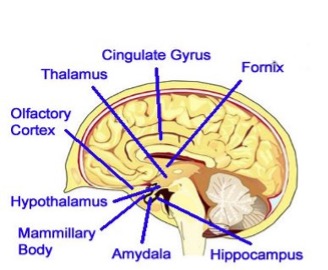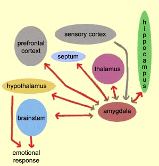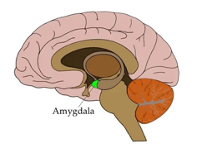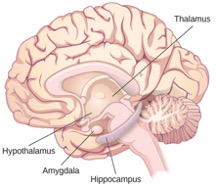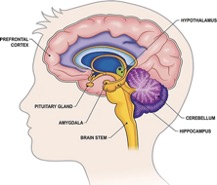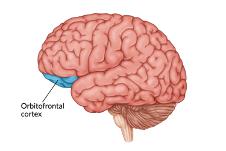The modern understanding of emotion creation, processing and transmitting is usually connected with James Papez’ studies and findings. According to Anita Deak: “Papez (1937) has described not one single center for emotions (such as the thalamus or the hypothalamus) but a neural circuit within several brain structures. The Papez circuit consists of the thalamus, the hypothalamus, the mamillary bodies, the cingular gyrus, and the hippocampus (Dalgleish, 2004). He has also suggested pathways among these structures where information is transmitted during an emotional state. (…)
¿De dónde vienen las emociones? El cerebro emocional
3 temas | 2 Cuestionarios
Clasificación de las emociones
3 temas | 1 la prueba
Las emociones y el cerebro social
2 temas | 1 la prueba
aprendizaje y emociones
4 temas
El cerebro emocional: creación, procesamiento y transmisión de emociones
The limbic system has often been mentioned as the central region for emotions. (…) The limbic system consists of the Papez circuit extended with the septal areas, the nucleus accumbens, the amygdala and the orbitofrontal cortex” (Deak, 2011: 72).
Si quieres leer más sobre el cerebro emocional:
- Dalgleish, T. The emotional brain. Nature Reviews Neuroscience, vol. 5, no. 7, pp. 582–589, 2004. https://stanford.edu/~knutson/ans/dalgleish04.pdf
- Deak, A. Cerebro y emoción: neurociencia cognitiva de las emociones. Revisión de Psicología, 2011, vol. 18, núm. 2, 71-80. http://mjesec.ffzg.hr/revija.psi/vol%2018%20no%202%202011/Deak%203.pdf
Las partes del sistema límbico funcionan en forma integrada y son mutuamente dependientes en el proceso de creación y transmisión de emociones. Notas de Kathryn Elizabeth Patten sobre la complejidad de estas relaciones:
“Neuroscientists have rejected the idea that specific parts of the brain perform designated singular tasks and assert that brain parts are highly integrated (Murphy, Nimmo-Smith, & Laurence: 2003), and while specific parts such as the amygdalae function as the hub for certain tasks, they do not perform these tasks alone, but serve to orchestrate and coordinate neuronal activity. Damasio, Ledoux, and Goleman focus on the neural and physiological substrates of emotion as a basis for their theories and hypotheses about the role of emotion (Patten: 2008).”
El cerebro emocional - la amídala
¿Qué representa la amígdala y dónde se encuentra?
La amígdala es un colección de núcleos encontrado en lo profundo del lóbulo temporal. The term “amygdala” comes from Greek and means “almond“, because one of the most prominent nuclei of the amygdala has an almond-like shape. Although we often refer to it in the singular, there are two amygdalae—one in each cerebral hemisphere.
¿Cuáles son las funciones de la amígdala?
Sometimes it is called “the aggression centre”. The amygdala is related to emotion, particularly in processing of aversive information (LeDoux: 1996).
It is best known for its role in the processing of fear (and also anger and anxiety), but this is an oversimplified perspective on amygdala function.
There is evidence that amygdala is also involved in processing pleasant information, such as:
- relacionado con el aprendizaje de recompensas (Adolphs: 2010; Janak y Tye: 2015),
- codificación de memoria episódica (Hamann et al.: 1999; Dolcos et al.: 2004),
- escena agradable o percepción de la cara (Sabatinelli et al.: 2011),
- imaginería mental de experiencias placenteras (Costa et al.: 2010).
In a broader sense, the amygdala is a key structure triggering the organisms’ survival circuit (fight or flight reactions) that is organized into distinct motivational systems, the appetitive and defensive motivation system (Lang, Bradley: 2010).
Otras estructuras cerebrales responsables de la formación y procesamiento de las emociones
TÁLAMO – a sensory relay center (recoge entradas sensoriales: visual, auditivo y somatosensorial), sus neuronas proyectan señales tanto a la amígdala como a las regiones corticales superiores para su posterior procesamiento.
HIPOTÁLAMO – is involucrados en la expresión de emociones, en lugar de su generación. Su papel se extiende a muchos niveles, regulando la motricidad, las respuestas emocionales, la tensión arterial, etc.HIPOCAMPO – asociado con el aprendizaje y las emociones.. Es una parte clave en la red cerebral emocional y es responsable de la cognición social y el procesamiento de las emociones. También es importante en la memoria espacial, la navegación y ayuda a convertir la memoria a corto plazo en memoria a largo plazo.
corteza orbitofrontal
Una de las principales teorías de la emoción es que las emociones son estados provocados por recompensas y castigos, los cuales son reforzadores instrumentales (Rolls, 2000, 2013b, 2014, 2018a) (Fig. 6). Según esta teoría el papel de la OFC en la emoción es decodificar la recompensa/castigo metas para la acción, representando el valor de la recompensa y aprendiendo sobre estímulos con contingencias de recompensa versus sin recompensa, y luego transmitiendo las representaciones resultantes a otras regiones del cerebro (como la corteza cingulada) que implementan el aprendizaje de acciones para obtener los resultados de recompensa, señalado por la OFC (Rolls, 2019a,b; Rolls, 2021a).
Although the amygdala has many of the same connections as the OFC, it is an evolutionarily old brain region, and appears to be overshadowed by the OFC in humans, in that the effects of damage to the human amygdala on emotion and emotional experience are much more subtle. LeDoux and colleagues have emphasized the evidence that the human amygdala is rather little involved in subjective emotional experience (LeDoux, Pine, 2016; LeDoux, Brown, 2017; LeDoux et al, 2018). That is in strong contrast to the OFC, which is involved in subjective emotional experience.
These processes—assessing the social rank of individuals, learning from social partners, anticipating their behaviour—are critical for social life. However, the balance (of functions of amygdala and OFC) may shift towards the OFC in humans, in that it is OFC damage in humans that produces profound changes in social and emotional behavior, and subjective emotional experience, as well as in reward reversal learning (Rolls et al., 1994; Hornak et al., 1996; 2003; Berlin et al., 2004, 2005; Hornak et al., 2004; Rolls, 2019c).
Cuestionarios
